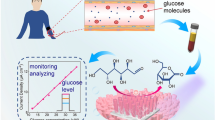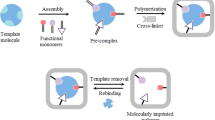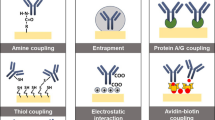Abstract
Chemiluminescence (CL) emission from luminol–tetrachloroaurate ([AuCl4]−) system studied in presence of monosaccharide sugars such as glucose and fructose was investigated on a microfluidic chip fabricated by the soft lithography technique. CL emission from the luminol–[AuCl4]− system at 430 nm was intensified remarkably by the catalytic activity of glucose and fructose at room temperature. Under optimized conditions, the CL emission intensity of the system was found to be linearly related to the concentration of the sugars. Based on this observation, nonenzymatic determination of total sugar (glucose, fructose, or hydrolyzable sucrose) was performed in a rapid and sensitive analytical method. The results revealed that the linearity ranged from 9 to 1,750 μM for glucose and 80 to 1,750 μM for fructose, with a limit of detection of 0.65 and 0.69 μM, respectively. The relative standard deviations determined at 250 μM based on six repetitive injections were 1.13 and 1.15 % for glucose and fructose, respectively. The developed method was successfully applied for determination of the total sugar concentration in food and beverages.

Schematic diagram and plausible chemical reaction scheme of microfluidic chip based enzymless determination of total sugar concentration. (a) CL emission for reaction between luminol and [AuCl4]- in absence of sugar; (b) Enhanced CL emission when reaction mixture of reducing sugar and [AuCl4]- merge with the luminol stream in the chip. SP-1, SP-2, and SP-3 represent the syringe pumps that deliver H2O/Sugar sample, [AuCl4]- and luminol solution, respectively, to the chip. M first mixing zone; D mixing and detection zone, W waste out






Similar content being viewed by others
References
Jimenez AM, Navas MJ (2002) Chemiluminescence methods (present and future). Grasas y Aceites 53:64–75
Imdadullah FT, Kumamaru T (1991) Chemiluminescence from the reaction of chloroauric acid with luminol in reverse micelles. Anal Chem 63:2348–2352
Maquieira A, Luque de Castro MD, Valcarcel M (1987) Determination of reducing sugars in wine by flow injection analysis. Analyst 112:1569–1572
Glinsmann WH, Irausquin H, Park YK (1986) Evaluation of health aspects of sugars contained in carbohydrate sweeteners. Report of sugar task force. J Nutr 116:S1–S216
Li M, Lee SH, Bae ZU, Lee KP, Park YC, Lee MS (2004) Optical sensor for the determination of glucose based on KIO4 chemiluminescence detection. J Fluoresc 14:597–601
Miskiewicz SJ, Arnett BB, Simon GE (1973) Evaluation of a glucose oxidase-peroxidase method adapted to the single-channel autoanalyzer and SMA 12/60. Clin Chem 19:253–257
Wu M, Lin Z, Dürkop A, Wolfbeis OS (2004) Time-resolved enzymatic determination of glucose using a fluorescent europium probe for hydrogen peroxide. Anal Bioanal Chem 380:619–626
Weigela B, Hitzmanna B, Kretzmera G, Schügerl K, Huwigb A, Giffhorn F (1996) Analysis of various sugars by means of immobilized enzyme coupled flow injection analysis. J Biotechnol 50:93–106
Koerner CA, Nieman TA (1986) Chemiluminescence flow injection analysis determination of sucrose using enzymatic conversion and a microporous membrane flow cell. Anal Chem 58:116–119
Park S, Boo H, Chunga TD (2006) Electrochemical non-enzymatic glucose sensors. Anal Chim Acta 556:46–57
Pérez-Ruiz T, Martínez-Lozano C, Tomás V, Fenoll J (2003) Chemiluminescence determination of glucose, fructose and their mixture by the stopped-flow mixing technique. Microchim Acta 141:73–78
Li B, He Y (2007) Simultaneous determination of glucose, fructose and lactose in food samples using a continuous-flow chemiluminescence method with the aid of artificial neural networks. Luminescence 22:317–325
García M, Escarpa A (2011) Disposable electrochemical detectors based on nickel nanowires for carbohydrate sensing. Biosens Bioelectron 26:2527–2533
García M, Escarpa A (2012) A class-selective and reliable electrochemical monosaccharide index in honeys, as determined using nickel and nickel-copper nanowires. Anal Bioanal Chem 402:945–953
Dou YH, Bao N, Xu JJ, Meng F, Chen HY (2004) Separation of proteins on surface-modified poly(dimethylsiloxane) microfluidic devices. Electrophoresis 25:3024–3031
Davidson CA, Lowe CR (2004) Optimisation of polymeric surface pre-treatment to prevent bacterial biofilm formation for use in microfluidics. J Mol Recognit 17:180–185
Wang X, Hofmann O, Das R, Barrett EM, de Mello AJ, de Mello JC, Bradley DDC (2006) Integrated thin-film polymer/fullerene photodetectors for on-chip microfluidic chemiluminescence detection. Lab Chip 7:58–63
Tsukagoshi K, Jinno N, Nakajima R (2005) Development of a micro total analysis system incorporating chemiluminescence detection and application to detection of cancer markers. Anal Chem 77:1684–1688
Hashimoto M, Tsukagoshi K, Nakajima R, Kondo K, Arai A (2000) Microchip capillary electrophoresis using on-line chemiluminescence detection. J Chromatogr A 867:271–279
Arora A, Eijkel JCT, Morf WE, Manz A (2001) A wireless electrochemiluminescence detector applied to direct and indirect detection for electrophoresis on a microfabricated glass device. Anal Chem 73:3282–3288
Karim MM, Lee SH, Lee HK, Bae ZU, Choi KH (2006) A batch chemiluminescence determination of enoxacin using a Tris-(1,10-phenanthroline)ruthenium(II)–cerium(IV) system. J Fluoresc 16:533–540
Ojeda CB, Rojas FS (2006) Recent development in optical chemical sensors coupling with flow injection analysis. Sensors 6:1245–1307
Sia SK, Whitesides GM (2003) Microfluidic devices fabricated in poly(dimethylsiloxane) for biological studies. Electrophoresis 24:3563–3576
Tan HY, Loke WK, Tan YT, Nguyen NT (2008) A lab-on-a-chip for detection of nerve agent sarin in blood. Lab Chip 8:885–891
Tan X, Song Z, Chen D, Wang Z (2011) Study on the chemiluminescence behavior of bovine serum albumin with luminol and its analytical application. Spectrochim Acta Part A 79:232–235
Cui H, Wang W, Duan C-F, Dong Y-P, Guo J-Z (2007) Synthesis, characterization, and electrochemiluminescence of luminol- reduced gold nanoparticles and their application in a hydrogen peroxide sensor. Chem Eur J 13:6975–6984
Gole A, Kumar A, Phadtare S, Mandale AB, Sastry M (2001) Glucose induced in-situ reduction of chloroaurate ions entrapped in a fatty amine film: formation of gold nanoparticle–lipid composites. PhysChemComm 4:92–95
Li Y, Yang P, Wang P, Wang L (2007) Development of a novel luminol chemiluminescent method catalyzed by gold nanoparticles for determination of estrogens. Anal Bioanal Chem 387:585–592
Palazzoa G, Facchinia L, Mallardi A (2012) Colorimetric detection of sugars based on gold nanoparticle formation. Sens Actuators B 161:366–371
Panigrahi S, Kundu S, Ghosh SK, Nath S, Pal T (2005) Sugar assisted evolution of mono- and bimetallic nanoparticles. Colloids Surf A 264:133–138
Kimling J, Maier M, Okenve B, Kotaidis V, Ballot H, Plech A (2006) Turkevich method for gold nanoparticle synthesis revisited. J Phys Chem B 110:15700–15707
Acknowledgments
This research was supported by Kyungpook National University Research Fund, 2011
Author information
Authors and Affiliations
Corresponding author
Electronic supplementary material
Below is the link to the electronic supplementary material.
ESM 1
(PDF 3.60 MB)
Rights and permissions
About this article
Cite this article
Alam, AM., Kamruzzaman, M., Dang, TD. et al. Enzymeless determination of total sugar by luminol–tetrachloroaurate chemiluminescence on chip to analyze food samples. Anal Bioanal Chem 404, 3165–3173 (2012). https://doi.org/10.1007/s00216-012-6429-1
Received:
Revised:
Accepted:
Published:
Issue Date:
DOI: https://doi.org/10.1007/s00216-012-6429-1




